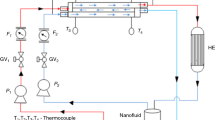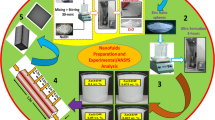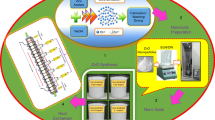Abstract
In recent decades, the growth of heat transfer using nanomaterials in the conventional base fluid has caught the attention of researchers around the world. The present research investigates the growth in heat transfer using ZnO-DW based nanofluids in a square heat exchanger. ZnO nanoparticles were synthesized by using the single-pot sonochemical technique. The ZnO-DW based nanofluids with different concentrations (0.1, 0.075, 0.05 and 0.025 mass%) were prepared by using probe sonication technique. The heat transfer growth will be benchmarked using the experimental data from distilled water experiment. Reynolds numbers, average convective heat transfer coefficient (h), and Nusselt number were calculated and analyzed in this investigation. Significant enhancement of 52% in thermal conductivity was noticed at 45 °C for 0.1 mass% concentration of ZnO-DW based nanofluids, which is due to the presence of maximum ZnO nanoparticles. Moreover, the maximum improvement in Nusselt values recorded at the end of the square pipe is 47% for 0.1 mass%, while 32%, 27% and 17% increase was recorded for 0.075, 0.05 and 0.025 mass% concentrations, and heat transfer enhancement was from 500 to 1100, 500 to 960, 500 to 910, and 500 to 900 W m−2 K−1 for different ZnO-DW based nanofluids mass% concentrations, which is more than water due to stability of nanoparticles. It can be concluded that the heat transfer performance enhancement is credited to the combination of square pipe and well-dispersed and stable ZnO-DW based nanofluids for heat exchanger applications.
Graphic abstract














Similar content being viewed by others
Abbreviations
- A :
-
The inner area of pipe
- D h :
-
Hydraulic diameter
- C P :
-
Heat capacity for nanofluid
- P P :
-
System pumping power
- Q :
-
Heat flux
- mass%:
-
Nanoparticles mass concentration
- k :
-
Thermal conductivity (W m−1 K−1)
- I :
-
Inlet condition
- PN:
-
Prantadel numbers (Pr = cp·η/k)
- S gen :
-
Entropy ratio
- B :
-
Bulk value
- c p :
-
Specific heat (J kg−1 K−1)
- Re:
-
Reynolds numbers (Re = ρ·v·D/η)
- T out :
-
Outlet temperature of fluid
- T in :
-
Inlet temperature of fluid
- T s :
-
Pipe surface temperature
- T b :
-
Fluid bulk temperature
- V :
-
Velocity (m s−1)
- nf:
-
Nanofluid
- bf:
-
Value of base fluid
- np:
-
Nanoparticle
- r:
-
Ratio
- µ :
-
Dynamical viscosity (MPa s)
- ρ :
-
Fluid density in (kg m−3)
- ω :
-
Mass concentration (%)
- ff:
-
Friction factor
- PEG:
-
Poly ethylene glycol
- TEM:
-
Transmission electron microscopy
- DW:
-
Distilled water
- TC:
-
Thermocouple
- HVAC:
-
High-voltage alternating current
References
Choi SU, Eastman JA. Enhancing thermal conductivity of fluids with nanoparticles (No. ANL/MSD/CP-84938; CONF-951135-29). Lemont: Argonne National Lab; 1995.
Aghahadi MH, Niknejadi M, Toghraie DJ. An experimental study on the rheological behavior of hybrid Tungsten oxide (WO3)-MWCNTs/engine oil Newtonian nanofluids. JoMS. 2019;1197:497–507.
Elsaid AM. Experimental study on the heat transfer performance and friction factor characteristics of Co3O4 and Al2O3 based H2O/(CH2OH) 2 nanofluids in a vehicle engine radiator. Int Commun Heat Mass Transfer. 2019;108:104263.
Xie H, Wang J, Xi T, Liu YJ. Thermal conductivity of suspensions containing nanosized SiC particles. IJT. 2002;23(2):571–80.
Leong KY, Razali I, Ahmad KK, Ong HC, Ghazali MJ, Rahman MRA. Thermal conductivity of an ethylene glycol/water-based nanofluid with copper-titanium dioxide nanoparticles: an experimental approach. Int Commun Heat Mass Transfer. 2018;90:23–8.
Pang C, Jung J-Y, Lee JW, Kang YTJ. Thermal conductivity measurement of methanol-based nanofluids with Al2O3 and SiO2 nanoparticles. IJHMT. 2012;55(21–22):5597–602.
Pourfattah F, Motamedian M, Sheikhzadeh G, Toghraie D, Akbari OA. The numerical investigation of angle of attack of inclined rectangular rib on the turbulent heat transfer of water–Al2O3 nanofluid in a tube. IJMS. 2017;131:1106–16.
Qiu L, Zhu N, Feng Y, Michaelides EE, Żyła G, Jing D, et al. A review of recent advances in thermophysical properties at the nanoscale: from solid state to colloids. Phys Rep 2019;843:1–81.
Qiu L, Zhu N, Zou H, Feng Y, Zhang X, Tang DJ, et al. Advances in thermal transport properties at nanoscale in China. IJoH. 2018;125:413–33.
Wen D, Ding Y. Experimental investigation into convective heat transfer of nanofluids at the entrance region under laminar flow conditions. Int J Heat Mass Transf. 2004;47(24):5181–8.
Sadeghinezhad E, Mehrali M, Tahan Latibari S, Mehrali M, Kazi SN, Oon CS, et al. Experimental investigation of convective heat transfer using graphene nanoplatelet based nanofluids under turbulent flow conditions. Ind Eng Chem Res. 2014;53(31):12455–65. https://doi.org/10.1021/ie501947u.
Elsaid AM. Experimental study on the heat transfer performance and friction factor characteristics of Co3O4 and Al2O3 based H2O/(CH2OH) 2 nanofluids in a vehicle engine radiator. ICHMT. 2019;108:104263.
Abdelrazek AH, Kazi S, Alawi OA, Yusoff N, Oon CS, Ali HM, et al. Heat transfer and pressure drop investigation through pipe with different shapes using different types of nanofluids. JTAC. 2020;139:1637–53.
Wen D, Ding YJ. Experimental investigation into convective heat transfer of nanofluids at the entrance region under laminar flow conditions. IJHMT. 2004;47(24):5181–8.
Heydari M, Toghraie D, Akbari OA. The effect of semi-attached and offset mid-truncated ribs and water/TiO2 nanofluid on flow and heat transfer properties in a triangular microchannel. TSEP. 2017;2:140–50.
Baïri A. Experimental study on enhancement of free convective heat transfer in a tilted hemispherical enclosure by using water–ZnO nanofluid saturated porous materials. Appl Therm Eng. 2019;148:992–8.
Sarafraz M, Arya H, Saeedi M, Ahmadi D. Flow boiling heat transfer to MgO-therminol 66 heat transfer fluid: experimental assessment and correlation development. Appl Therm Eng. 2018;138:552–62.
Esfe MH, Zabihi F, Rostamian H, Esfandeh S. Experimental investigation and model development of the non-Newtonian behavior of CuO-MWCNT-10w40 hybrid nano-lubricant for lubrication purposes. J Mol Liq. 2018;249:677–87.
Shahsavar A, Moradi M, Bahiraei M. Heat transfer and entropy generation optimization for flow of a non-Newtonian hybrid nanofluid containing coated CNT/Fe3O4 nanoparticles in a concentric annulus. Journal of the Taiwan Institute of Chemical Engineers. 2018;84:28–40.
Shahsavar A, Sardari PT, Toghraie DJ. Free convection heat transfer and entropy generation analysis of water–Fe3O4/CNT hybrid nanofluid in a concentric annulus. Int J Numer Methods Heat & Fluid Flow. 2019.
Esfe MH, Arani AAA, Madadi MR, Alirezaie A. A study on rheological characteristics of hybrid nano-lubricants containing MWCNT-TiO2 nanoparticles. J Mol Liq. 2018;260:229–36.
Bahiraei M, Godini A, Shahsavar A. Thermal and hydraulic characteristics of a minichannel heat exchanger operated with a non-Newtonian hybrid nanofluid. Journal of the Taiwan Institute of Chemical Engineers. 2018;84:149–61.
Huminic G, Huminic A. The influence of hybrid nanofluids on the performances of elliptical tube: recent research and numerical study. Int J Heat Mass Transf. 2019;129:132–43.
Afshari A, Akbari M, Toghraie D, Yazdi ME. Experimental investigation of rheological behavior of the hybrid nanofluid of MWCNT-alumina/water (80%)–ethylene-glycol (20%). JTAC. 2018;132(2):1001–15.
Aberoumand S, Jafarimoghaddam A. Experimental study on synthesis, stability, thermal conductivity and viscosity of Cu-engine oil nanofluid. Journal of the Taiwan Institute of Chemical Engineers. 2017;71:315–22.
Moradi A, Toghraie D, Isfahani AHM, Hosseinian AJ. An experimental study on MWCNT-water nanofluids flow and heat transfer in double-pipe heat exchanger using porous media. JTAC. 2019;137:1797–807.
Sadri R, Hosseini M, Kazi SN, Bagheri S, Abdelrazek AH, Ahmadi G, et al. A facile, bio-based, novel approach for synthesis of covalently functionalized graphene nanoplatelet nano-coolants toward improved thermo-physical and heat transfer properties. J Colloid Interface Sci. 2018;509:140–52.
Yoo D-H, Hong K, Yang H-S. Study of thermal conductivity of nanofluids for the application of heat transfer fluids. JTA. 2007;455(1–2):66–9.
Tiwari AK, Ghosh P, Sarkar J. Performance comparison of the plate heat exchanger using different nanofluids. Exp Thermal Fluid Sci. 2013;49:141–51.
Ruhani B, Barnoon P, Toghraie DJ. Statistical investigation for developing a new model for rheological behavior of silica-ethylene glycol/water hybrid Newtonian nanofluid using experimental data. PASMA. 2019;525:616–27.
Kherbeet AS, Mohammed H, Salman BJ. The effect of nanofluids flow on mixed convection heat transfer over microscale backward-facing step. IJHMT. 2012;55(21–22):5870–81.
Hernaiz M, Alonso V, Estellé P, Wu Z, Sundén B, Doretti L, et al. The contact angle of nanofluids as thermophysical property. J Colloid Interface Sci. 2019;547:393–406.
Al-Shamani AN, Yazdi MH, Alghoul M, Abed AM, Ruslan MH, Mat S, et al. Nanofluids for improved efficiency in cooling solar collectors—a review. RSER. 2014;38:348–67.
Zadeh AD, Toghraie DJ. Experimental investigation for developing a new model for the dynamic viscosity of silver/ethylene glycol nanofluid at different temperatures and solid volume fractions. JTAC. 2018;131(2):1449–61.
Suganthi K, Rajan K. ZnO-propylene glycol-water nanofluids with improved properties for potential applications in renewable energy and thermal management. CSAPEA. 2016;506:63–73.
Satdeve NS, Ugwekar RP, Bhanvase BA. Ultrasound assisted preparation and characterization of Ag supported on ZnO nanoparticles for visible light degradation of methylene blue dye. J Mol Liq. 2019;291:111313.
Patil PP, Bohara RA, Meshram JV, Nanaware SG, Pawar SH. Hybrid chitosan-ZnO nanoparticles coated with a sonochemical technique on silk fibroin-PVA composite film: a synergistic antibacterial activity. IJBM. 2019;122:1305–12.
Suganthi K, Rajan KJ. Temperature induced changes in ZnO–water nanofluid: zeta potential, size distribution and viscosity profiles. IJHMT. 2012;55(25–26):7969–80.
Suganthi K, Rajan KJ. A formulation strategy for preparation of ZnO–propylene glycol–water nanofluids with improved transport properties. IJHMT. 2014;71:653–63.
Witharana S, Palabiyik I, Musina Z, Ding YJ. Stability of glycol nanofluids—the theory and experiment. PT. 2013;239:72–7.
Fedele L, Colla L, Bobbo S, Barison S, Agresti FJ. Experimental stability analysis of different water-based nanofluids. NRL. 2011;6(1):300.
Fernández-Seara J, Uhía FJ, Sieres J, Campo AJ. A general review of the Wilson plot method and its modifications to determine convection coefficients in heat exchange devices. ATE. 2007;27(17–18):2745–57.
Duangthongsuk W, Wongwises S. Effect of thermophysical properties models on the predicting of the convective heat transfer coefficient for low concentration nanofluid. ICHTM. 2008;35(10):1320–6.
Gnielinski VJ. New equations for heat and mass transfer in the turbulent flow in pipes and channels. NSrtrA. 1975;75:8–16.
Petukhov B. Heat transfer and friction in turbulent pipe flow with variable physical properties. Advances in heat transfer. Amsterdam: Elsevier; 1970. p. 503–64.
Mansour RB, Galanis N, Nguyen CT. Effect of uncertainties in physical properties on forced convection heat transfer with nanofluids. ATE. 2007;27(1):240–9.
Hamilton RL, Crosser OJ. Thermal conductivity of heterogeneous two-component systems. IECF. 1962;1(3):187–91.
Holman JP, Gajda WJ. Experimental methods for engineers. New York: McGraw-Hill; 2001.
Xu S, Fu L, Pham TSH, Yu A, Han F, Chen L. Preparation of ZnO flower/reduced graphene oxide composite with enhanced photocatalytic performance under sunlight. CI. 2015;41(3):4007–13.
Patel HE, Sundararajan T, Das SK. An experimental investigation into the thermal conductivity enhancement in oxide and metallic nanofluids. JNR. 2010;12(3):1015–31.
Patterson A. The Scherrer formula for X-ray particle size determination. PR. 1939;56(10):978.
Poongavanam GK, Ramalingam V. Characteristics investigation on thermophysical properties of synthesized activated carbon nanoparticles dispersed in solar glycol. Int J Therm Sci. 2019;136:15–32.
Pak BC, Cho YI. Hydrodynamic and heat transfer study of dispersed fluids with submicron metallic oxide particles. Experimental Heat Transfer an International Journal. 1998;11(2):151–70.
Amiri A, Sadri R, Shanbedi M, Ahmadi G, Kazi S, Chew B, et al. Synthesis of ethylene glycol-treated graphene nanoplatelets with one-pot, microwave-assisted functionalization for use as a high performance engine coolant. Energy Convers Manag. 2015;101:767–77.
Goudarzi K, Jamali H. Heat transfer enhancement of Al2O3-EG nanofluid in a car radiator with wire coil inserts. ATE. 2017;118:510–7.
Acknowledgements
Authors gratefully acknowledge the UMRG Grant RP045C-17AET, UM Research University Grant GPF050A-2018, Institute of Advanced Studies, Nanotechnology and Catalysis Research Center, and UM Research University Grant GPF017A-2019, Department of Mechanical Engineering and the University of Malaya for the support to conduct this research work.
Author information
Authors and Affiliations
Corresponding authors
Ethics declarations
Conflict of interest
The author professed that there is no conflict of interest.
Additional information
Publisher's Note
Springer Nature remains neutral with regard to jurisdictional claims in published maps and institutional affiliations.
Rights and permissions
About this article
Cite this article
Ahmed, W., Chowdhury, Z.Z., Kazi, S.N. et al. Characteristics investigation on heat transfer growth of sonochemically synthesized ZnO-DW based nanofluids inside square heat exchanger. J Therm Anal Calorim 144, 1517–1534 (2021). https://doi.org/10.1007/s10973-020-09593-z
Received:
Accepted:
Published:
Issue Date:
DOI: https://doi.org/10.1007/s10973-020-09593-z




